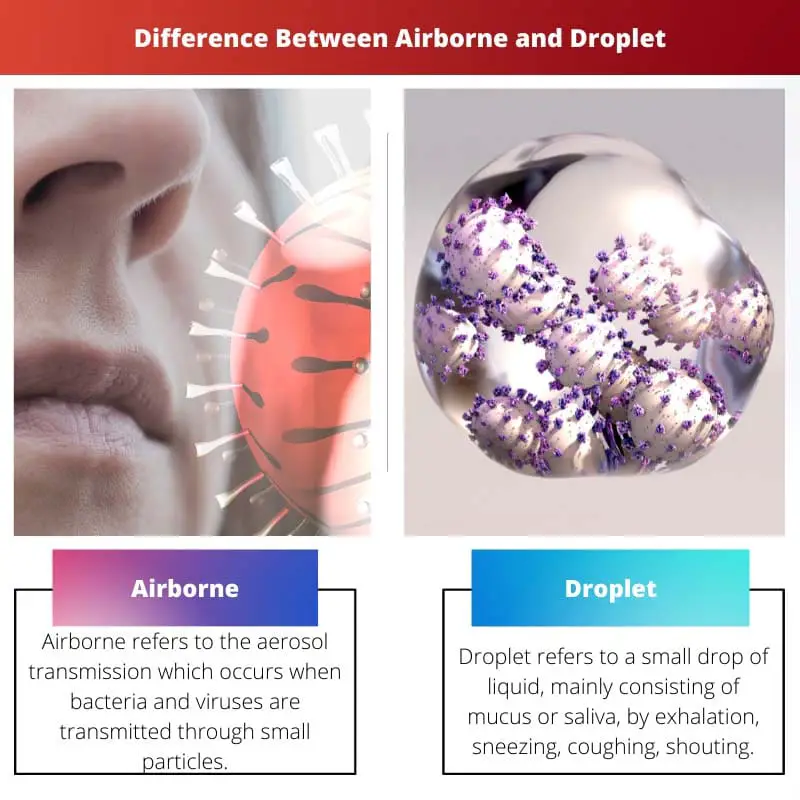Health workers and health agencies always recommend transmission-based precautions like airborne precautions, droplet precautions, and contact to avoid transmitting respiratory viruses.
There are several differences between an airborne and a droplet, which can be transmitted to the human body, causing illness.
Key Takeaways
- Airborne transmission occurs when infectious agents travel in aerosols, allowing them to remain suspended in the air for extended periods. In contrast, droplet transmission involves larger respiratory droplets that fall to surfaces quickly.
- Airborne pathogens like the measles virus can spread over long distances and remain infectious for hours. In contrast, droplet-spread pathogens, like the flu virus, require close contact for transmission.
- Preventive measures for airborne diseases include proper ventilation and air filtration, whereas droplet precautions involve maintaining physical distance, wearing masks, and practicing hand hygiene.
Airborne vs Droplet
The difference between airborne and droplet is that airborne refers to aerosol transmission, where infectious viruses and bacteria are transmitted through tiny particles or droplets in the air; on the other hand, droplet refers to a small drop of liquid in the stand through which many infectious bacteria or viruses travel in the air and enter into the human body.

Airborne refers to aerosol transmission where droplets containing bacteria or viruses float in the air and are transmitted to the human body through inhaling.
According to WHO, it transmitted infections by particles measuring 5 micrometres or smaller than is seen as airborne transmission. It can be generated through sneezing, coughing, or even through exhaling.
A droplet is a small drop of liquid mainly made of water with some inclusion. Viruses and bacteria can be transmitted through the droplet in the air and enter the human body.
According to WHO, a droplet is measured at 5 micrometres or more significant than that. Droplets are produced by a human in several ways, like coughing, sneezing, shouting, singing, etc.
Comparison Table
| Parameters of Comparison | Airborne | Droplet |
|---|---|---|
| Definition | Airborne viruses and bacteria can travel more (30 to 60 centimetres) than the droplet. | WHO has determined the size of airborne 5 micrometres or smaller than that. |
| Size | WHO has determined the size of droplets to be 5 micrometres or more significant than that. | A mask is aerosolised to prevent airborne disease, but using sanitizer is not required. |
| Transmission | A mask is aerosolised to prevent airborne disease, but using sanitiser is not required. | Droplet transmission is the transmission of bacteria and viruses through a droplet through human sneezing, coughing, shouting, or singing. |
| Distance | Droplets travel minimal distances and mainly depend on the airflow. | A droplet is a liquid mainly consisting of water produced by humans (through sneezing, coughing, shouting) through which viruses and bacteria are transmitted. |
| Precautionary steps | When viruses and bacteria travel through droplets, aerosolize, and enter the human body, it is called airborne disease. | For preventing droplet spread diseases, sanitiser played asanitizerant role. Avoiding physical contact is helpful in this case. |
What is Airborne?
Airborne refers to aerosol transmission, which occurs when bacteria and viruses are transmitted through small particles or droplets in the air and travel to the human body. According to WHO, aerosols measured five micrometres or less in size.
Airborne diseases are prone to transmit through the air from one person to another. Biological waste and infectious sources of the human body can generate aerosols. Infectious aerosols can travel in the air a long distance (30 to 6o centimetres).
Airborne allergens or pathogens enter the human body through the throat, lungs, sinuses, and nose. The respiratory system might be affected by inhaling these allergens, and the infection can spread to the whole body.
There are mainly three types of airborne transmission- opportunistic airborne, preferential airborne, and obligate airborne.
Preferential airborne diseases are transmitted through primary aerosols but can be transmitted through other routes (for example- chickenpox).
Obligate airborne diseases spread only through aerosols (for example- tuberculosis). Opportunistic airborne infections spread only through other routes (for example- influenza).
Air pollution has a vital role in transmitting airborne diseases. The pollutants can influence lung functions by enhancing airway inflammation.
Other diseases like influenza, norovirus, chickenpox, and measles morbillivirus are airborne. Some airborne diseases affect non-humans, like Newcastle disease, where domestic poultry was affected.
What is a Droplet?
A droplet refers to a small drop of liquid, mainly mucus or saliva, by exhalation, sneezing, coughing, or shouting. It is produced naturally through breathing, sneezing, and coughing.
According to WHO, droplets are measured 5 micrometres or more significant than that. These human droplets can transmit many infectious viruses and bacteria.
There are two types of droplets- aerosol droplets and respiratory droplets. Aerosol droplets are smaller and transmit viruses and bacteria by floating in the air and entering the human body.
On the other hand, the respiratory droplet is larger than the aerosol. These types of droplets transmit diseases by contact or physical touch.
Respiratory droplets are produced by a human in several ways, like sneezing, breathing, coughing, shouting, singing, etc. Respiratory droplets containing viruses or bacteria transmit infectious diseases through contact.
Viruses that are spread by droplet transmission are norovirus, coronavirus, rhinovirus, influenza virus, respiratory syncytial virus, and so on.
For taking precautions against droplet transmission in healthcare institutions, patients are taken to an individual room, and proper PPE (personal protective equipment) is used.
Higher ventilation rates are also used for removing and diluting respiratory particles as a hazard control. Surgical masks are also helpful in preventing droplet transmission.
Any physical contact like a handshake needs to be avoided to take precautions against droplet transmission.
Main Differences Between Airborne and Droplet
- Airborne is aerosol transmission where viruses and bacteria are transmitted through droplets in the air. On the other hand, the droplet is the drop of liquid mainly consisting of water and produced by humans (through sneezing, coughing, shouting) through which viruses and bacteria are transmitted.
- WHO has determined the size of airborne 5 micrometres or smaller than that. According to WHO, droplets are measured 5 micrometres or larger than that.
- When viruses and bacteria travel through droplets, become aerosolized, and enter into the human body, it is called airborne disease. Droplet transmission is the transmission of bacteria and viruses through a droplet through human sneezing, coughing, shouting, or singing.
- Airborne viruses and bacteria can travel more (30 to 60 centimetres) than the droplet. Droplets travel very small distances and mainly depend on the airflow.
- For preventing airborne disease wearing a mask is very important but using sanitizer is not required. For preventing droplet spread diseases, sanitizer played a significant role. Avoiding physical contact is helpful in this case.






